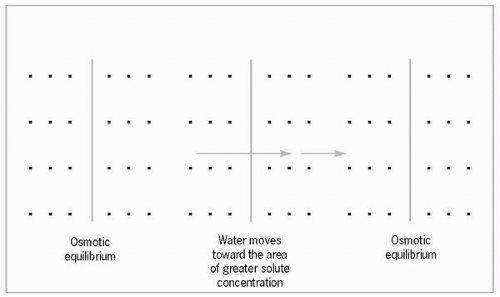Fluid Balance
Fluids are distributed in various compartments in the body, with movement back and forth to maintain homeostasis. This movement is a result of variations in hydrostatic pressure and osmotic forces, especially in interstitial and intravascular compartments. The fluid environment serves as the medium for exchange and distribution of electrolytes and nutrients and elimination of waste products from cellular metabolism.
Water makes up the largest component in the body and comprises approximately 60% of body weight. The three main fluid compartments are intracellular, extracellular, and intravascular. The intracellular compartment comprises fluids within cells, whereas the extracellular compartment comprises all the fluid outside the cells. This compartment is further divided into two smaller compartments: the interstitial (between cells) and the intravascular (blood plasma). Other extracellular compartments include those areas of the body containing smaller amounts of fluid such as lymphatic, synovial, cerebrospinal, pericardial, and others. These smaller compartments are important in particular diseases or conditions but are less so in terms of overall fluid and electrolyte balance and maintenance of homeostasis.
The percentage of total body water varies with age and amount of body fat. The greater the percentage of body fat, the lesser the amount of water present. Infants have a proportionally larger percent of total body
water, which makes them particularly vulnerable to shifts in fluid levels and dehydration. Their rapid metabolic rate, greater body surface area, and immature renal function also contribute to their susceptibility to fluid imbalances. This percentage decreases after 12 months of age and continues to decrease until adolescence. The elderly have proportionally smaller percentages of body water due to higher amounts of body fat, less lean tissue, and reduced ability of organ systems to compensate to maintain homeostasis. These variations are particularly important during periods of illness or stress, making the elderly especially vulnerable to dehydration, electrolyte imbalance, and system dysfunction.
water, which makes them particularly vulnerable to shifts in fluid levels and dehydration. Their rapid metabolic rate, greater body surface area, and immature renal function also contribute to their susceptibility to fluid imbalances. This percentage decreases after 12 months of age and continues to decrease until adolescence. The elderly have proportionally smaller percentages of body water due to higher amounts of body fat, less lean tissue, and reduced ability of organ systems to compensate to maintain homeostasis. These variations are particularly important during periods of illness or stress, making the elderly especially vulnerable to dehydration, electrolyte imbalance, and system dysfunction.
Daily fluid intake varies from person to person within a range of 2,400 to 3,200 mL, with roughly two-thirds obtained by oral intake of fluids and one-third obtained through food and water of oxidation (300 to 400 mL). Daily output balances intake in approximately the same proportions—two-thirds through urine and one-third through insensible losses. It is important to take insensible losses into account during periods of illness, such as diarrhea, ventilator-assisted breathing, diaphoresis, and fever, because these losses may be significantly increased.
Movement of water between the intracellular and extracellular fluid compartments is primarily affected by osmotic forces. Because water moves freely across cell membranes (i.e., toward the side with the greatest solute or particle concentration), an equilibrium
ordinarily exists between compartments. Sodium (Na+) is the most abundant extracellular ion and is responsible for maintaining osmotic balance in that compartment. Potassium (K+) performs the same role in the intracellular compartment. The osmotic force of intracellular proteins and active transport of ions out of the cell are additional forces contributing to this process.
ordinarily exists between compartments. Sodium (Na+) is the most abundant extracellular ion and is responsible for maintaining osmotic balance in that compartment. Potassium (K+) performs the same role in the intracellular compartment. The osmotic force of intracellular proteins and active transport of ions out of the cell are additional forces contributing to this process.
Plasma proteins play an important role in maintaining osmolality through plasma oncotic pressure in the intravascular compartment. These osmotic forces are balanced by hydrostatic pressure in the vascular compartment. Forces that favor movement of water out of the capillary and into the interstitial compartment are vascular hydrostatic pressure and interstitial fluid osmotic (oncotic) pressure. Forces that favor movement of water into the capillary from the interstitial compartment are interstitial hydrostatic pressure and vascular (plasma) osmotic pressure. The major forces for this filtration process are within the capillary membrane because plasma proteins do not readily cross it. Under normal circumstances, hydrostatic pressure exceeds capillary oncotic pressure at the arterial end of the capillary, causing water to move into the interstitial space. Consequently, hydrostatic pressure is lower than capillary oncotic pressure at the venous end of the capillary. This causes fluid to be reabsorbed back into the vascular system. Changes in capillary membrane permeability may alter this process by allowing plasma proteins to enter the interstitial space. Water follows, and edema results.
Stay updated, free articles. Join our Telegram channel

Full access? Get Clinical Tree






